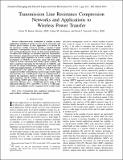Transmission Line Resistance Compression Networks and Applications to Wireless Power Transfer
Author(s)
Barton, Taylor W.; Gordonson, Joshua M.; Perreault, David J.
DownloadBarton Transmission Line Resistance Compression.pdf (2.520Mb)
OPEN_ACCESS_POLICY
Open Access Policy
Creative Commons Attribution-Noncommercial-Share Alike
Terms of use
Metadata
Show full item recordAbstract
Microwave-to-dc rectification is valuable in many applications, including RF energy recovery, dc-dc conversion, and wireless power transfer. In such applications, it is desired for the microwave rectifier system to provide a constant RF input impedance. Consequently, variation in rectifier input impedance over varying incident power levels can hurt system performance. To address this challenge, we introduce multiway transmission line resistance compression networks (TLRCNs) for maintaining near-constant input impedance in RF-to-dc rectifier systems. A development of TLRCNs is presented, along with their application to RF-to-dc conversion and wireless power transfer. We derive analytical expressions for the behavior of TLRCNs, and describe two design methodologies applicable to both single and multistage implementations. A 2.45-GHz four-way TLRCN network is implemented and applied to create a 4-W resistance compressed rectifier system that has narrow-range resistive input characteristics over a 10-dB power range. It is demonstrated to improve the impedance match to mostly resistive but variable input impedance class-E rectifiers over a 10-dB power range. The resulting TLRCN plus rectifier system has >50% RF-to-dc conversion efficiency over a >10-dB input power range at 2.45 GHz (peak efficiency 70%), and standing wave ratio <;1.1 over a 7.7-dB range, despite a nonnegligible reactive component in the rectifier loads.
Date issued
2014-04Department
Massachusetts Institute of Technology. Department of Electrical Engineering and Computer Science; Massachusetts Institute of Technology. Microsystems Technology LaboratoriesJournal
IEEE Journal of Emerging and Selected Topics in Power Electronics
Publisher
Institute of Electrical and Electronics Engineers (IEEE)
Citation
Barton, Taylor W., Joshua M. Gordonson, and David J. Perreault. “Transmission Line Resistance Compression Networks and Applications to Wireless Power Transfer.” IEEE Journal of Emerging and Selected Topics in Power Electronics 3, no. 1 (March 2015): 252–260.
Version: Author's final manuscript
ISSN
2168-6777
2168-6785